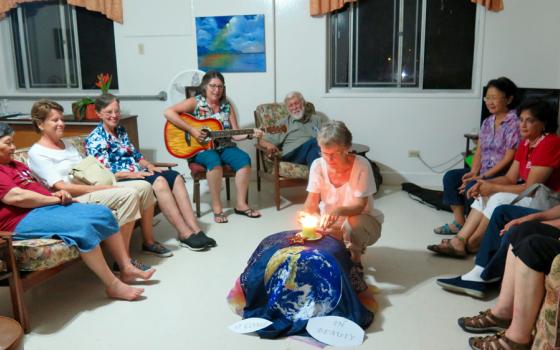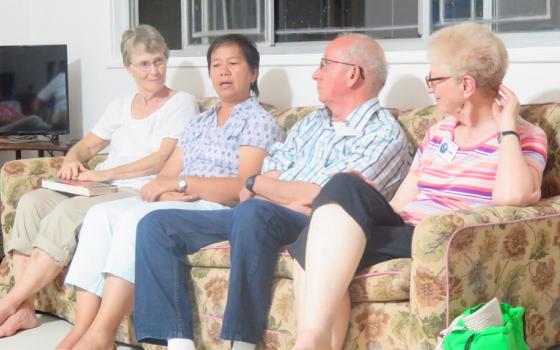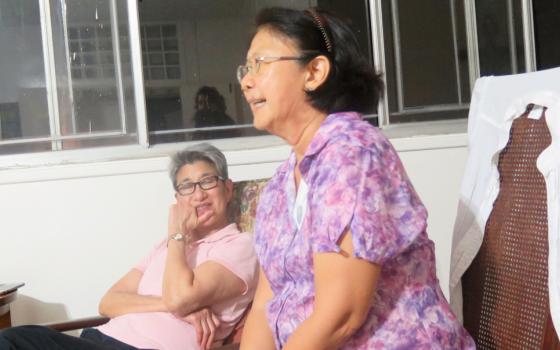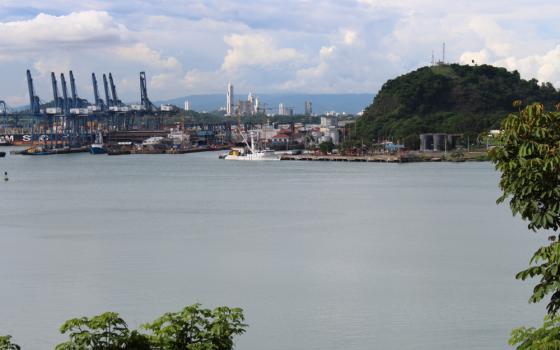The sun sets over the green mountains as papayas and palm trees sway in the breeze. Fifteen people from diverse walks of life and a 40-year span in ages gather in a circle as Maryknoll Sr. Peg Dillon assembles the altar at the center of the big yellow house, which is a five-minute drive from the Pacific Ocean. It's the home of the Maryknoll Sisters at the Fundación Nueva Vida (New Life Foundation), the setting for the first and last days of the Web of Life retreat.
"One of the energies of life is diversity, so there are many energies that form the web of life," Dillon begins. "We know that this web of life comes from that first moment 14 billion years ago, when that mystery of life we call God decided to express herself in creation."
The first in a 10-day series of explorations began with a ritual and reflection on origins of the universe. Attendees introduced themselves and shared a bit of their collective sum of life experience.
Dillon's creation story captures the wonder of creation from the standpoint of a school of thought known as evolutionary spirituality, connecting a sense of the divine with an expanding understanding of the sciences. Many among the group assembled here, who hail from Chile in the south, the Philippines in the east and the United States in the north, as well as Panama itself, share this understanding.
Among them is Maryknoll Sr. Ann Braudis, a world-renowned consultant on ecological and socioeconomic concerns who represented Maryknoll Sisters at the United Nations. In the wake of the 1990 earthquake in the Philippines, Braudis helped found the Maryknoll Ecological Sanctuary there, a model for the world, and served as its director for 15 years. She came to the Web of Life excited about the possibility of using it as a template to create something similar in the future.
"I'm completely convinced at the present time of the importance of bringing good scientific information into our spiritual teachings and spiritual practice," she said, "so I'm delighted to have this opportunity that brings into our realm the scientists and other speakers."
David Molineaux, a native New Yorker who nearly three decades ago picked up and moved his family to a new life in Chile, shared a bit of the story that led him to become a teacher and author of a new cosmic spirituality. Molineaux has written two books, Polvo de Estrellas (Dust of the Stars) and En El Principio Era el Sueño (In the Beginning was the Dream).
Maryknoll Sr. Jocelyn Fenix of the Philippines, a medical doctor who first came to Panama 25 years ago, spoke of the changes she has seen since she worked alongside Maryknoll Sr. Melinda Roper to establish the Maryknoll Pastoral Center in Santa Fe, Darién, four hours to the southwest of Panama City. This March, she returned to work at the center after four years working in the formation of sisters in Chicago.
"I come in a spirit of hope but also a spirit of sadness," she said. "I see what has happened in this bioregion in the past 25 years; even with the difficulty of trudging all the way there in the mud and on horseback in the first years, it was all mangroves and swamps and sea, we had the feeling of the land, of the sense of being called to the wonder and the beauty of Darién."
Much of that feeling has been lost to widespread environmental destruction, she said, but what the pastoral center has built there among the community has given her hope. That's what motivates her and what brought her back here, she said.
"I want the next generation to experience what it's like to have a beautiful place to live and to enjoy what it means to have the Earth, to grow up in wonder and beauty and awe," she said.
Fr. José María Vigil, a Claretian priest and a native of Spain, spoke of his "second birth" when he moved to Nicaragua at the height of the Nicaraguan Revolution. He also talked about the shift of the church to liberation theology and a newer shift to embrace ecology. He is currently working on a book inspired by these experiences.
Maryknoll Sr. Geraldine Brake, the lead sister in the Panama City mission and one of the Web of Life organizers, grew up in Delaware in a family of 12. She arrived in Nicaragua in 1972; a day later, the country was hit by a devastating earthquake. She stayed to help rebuild and lived through much of the Nicaraguan Revolution.
When it was time to choose a new home, she decided on Panama.
"I thought it would be good for my nerves," she said with a laugh.
But soon after her arrival in 1989 came the U.S. invasion of the country, which killed an estimated 2,000 people and devastated several poor communities in Panama City. Brake's mission evolved from that invasion when she saw the hundreds of people left homeless, many of them elderly and poor. She decided to build a nursing home for them, and the Fundación Nueva Vida was born.
Sharing stories, songs and a salute to the four directions, the group began to build a sense of community that will carry them through the next 10 days in Panama. Dillon shared a reading from a favorite book, Ask the Beasts: Darwin and the God of Love by Sr. Joseph Sr. Elizabeth A. Johnson. She was discussing a passage from the book of Job:
"If you interrogate the flora and fauna of land, air, and sea, the text suggests, their response will lead your mind and heart to the living God, generous source and sustaining power of their life. In their beauty, their variety, their interacting, their coming to be and passing away, they witness to the overflowing goodness of their Creator. They even teach something about human beings, that these members of the community of life also receive their every breath from the same immensely immeasurable Giver of life."
The next Web of Life dispatch will include a tour of Frank Gehry's celebrated Biomuseo, or Biodiversity Museum, and a talk with executive architect Patrick Dillon, who worked alongside Gehry in the museum's planning and design.
[Tracy L. Barnett is an independent writer, editor and photographer specializing in environmental issues, indigenous rights and sustainable travel.]





